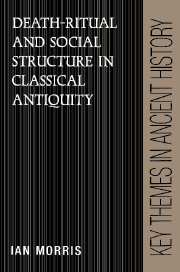Book contents
- Frontmatter
- Contents
- List of figures
- List of tables
- Preface
- Abbreviations
- 1 Map of sites in the Roman empire discussed in this book
- 2 Map of sites in Greece discussed in this book
- 1 The anthropology of a dead world
- 2 ‘Mos Romanus’: cremation and inhumation in the Roman empire
- 3 ‘Dem bones’: skeletal remains
- 4 Taking it with you: grave goods and Athenian democracy
- 5 Monuments to the dead: display and wealth in classical Greece
- 6 Famous last words: the inscribed tombstone
- 7 At the bottom of the graves: an example of analysis
- 8 Conclusion
- Bibliographical essay
- Bibliography
- Index
6 - Famous last words: the inscribed tombstone
Published online by Cambridge University Press: 02 December 2009
- Frontmatter
- Contents
- List of figures
- List of tables
- Preface
- Abbreviations
- 1 Map of sites in the Roman empire discussed in this book
- 2 Map of sites in Greece discussed in this book
- 1 The anthropology of a dead world
- 2 ‘Mos Romanus’: cremation and inhumation in the Roman empire
- 3 ‘Dem bones’: skeletal remains
- 4 Taking it with you: grave goods and Athenian democracy
- 5 Monuments to the dead: display and wealth in classical Greece
- 6 Famous last words: the inscribed tombstone
- 7 At the bottom of the graves: an example of analysis
- 8 Conclusion
- Bibliographical essay
- Bibliography
- Index
Summary
‘[A]lmost an embarrassment of riches’, says Rick Jones (1977: 21), in describing a cemetery of 150 Roman graves at Lattes, where thirty-four inscribed tombstones were found in situ. If these few are embarrassing, what of the other 180,000 epitaphs from the western Roman empire, or the 10,000 from classical Attica alone? Inscribed tombstones combine the second and fourth levels of the hierarchy of sources which I set out on p. 10, and sometimes the third as well. By examining ancient decisions to inscribe or not to inscribe a monument and then what to say on it, we should be able to enlarge substantially our understanding of the symbolic construction of society that took place in funeral rituals. But on the whole, this has proved extremely difficult to do. Tombstones are only rarely found in direct association with the burials for which they were set up; most have turned up reused as building blocks or in the diggings of antiquarians, who did not bother about recording contextual details. Consequently, there are major problems in treating them as part of the rites which separated the living from the dead, or in assessing their visual impact in the landscape of later generations. Their standard presentation, as serried ranks of repetitive entries in yellowing tomes known to initiates by obscure acronyms like ICUR or IG II/III2, makes the imaginative leap still greater.
In this chapter I examine several recent attempts to use funerary inscriptions in social history.
- Type
- Chapter
- Information
- Death-Ritual and Social Structure in Classical Antiquity , pp. 156 - 173Publisher: Cambridge University PressPrint publication year: 1992



